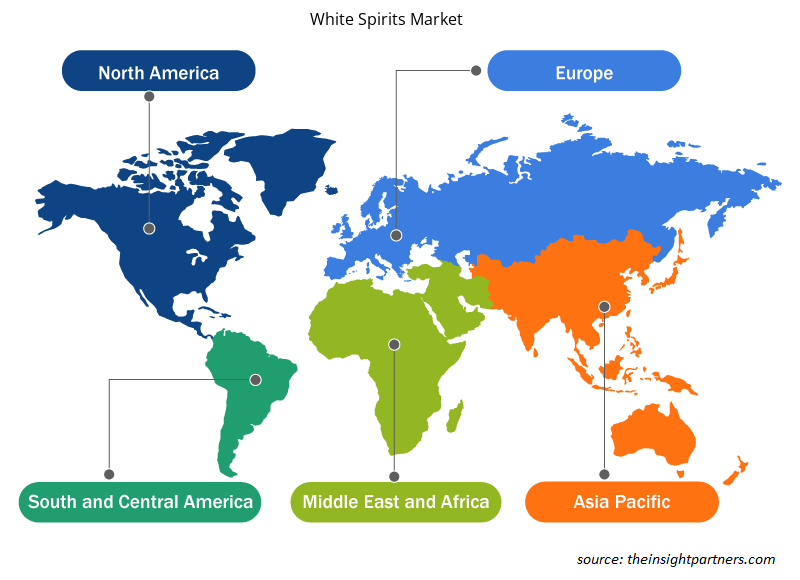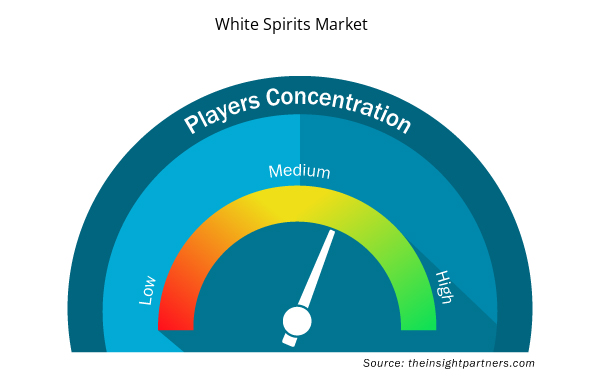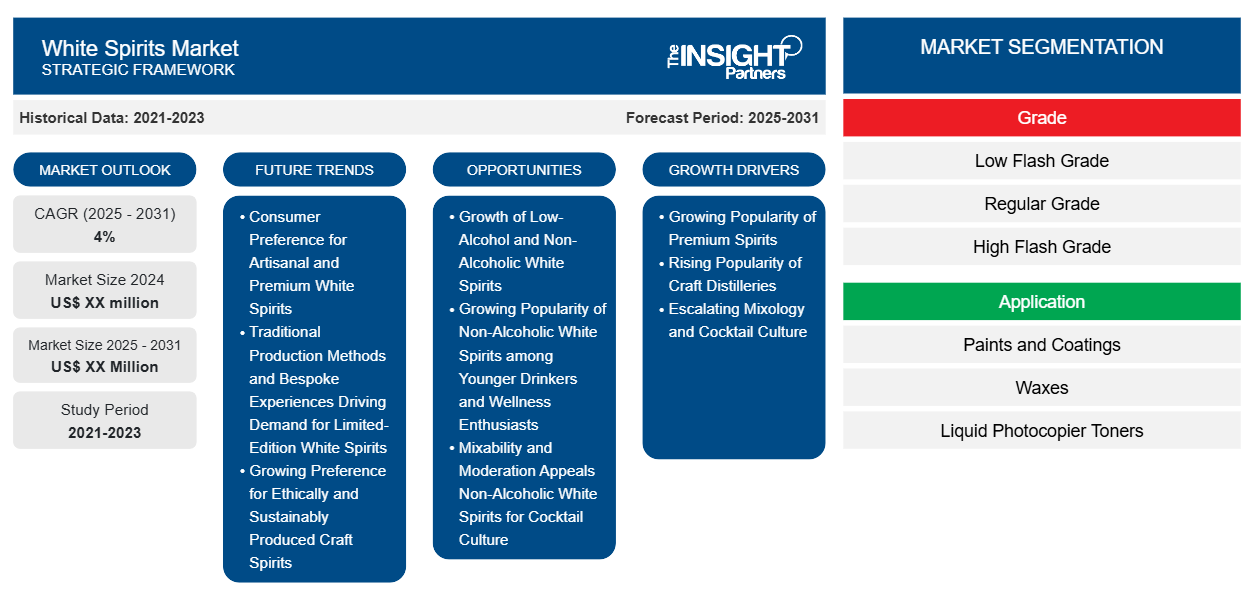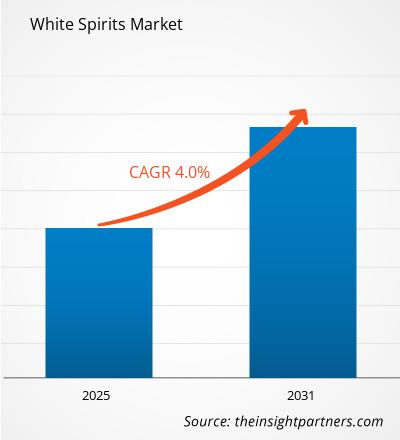Le marché des spiritueux blancs devrait enregistrer un TCAC de 4 % de 2023 à 2031, avec une taille de marché passant de XX millions USD en 2023 à XX millions USD d'ici 2031.
Le rapport présente une analyse basée sur la qualité (qualité à faible flash, qualité régulière et qualité à flash élevé). Le rapport est segmenté par application (peintures et revêtements, cires, toners liquides pour photocopieurs, adhésifs, encres d'impression et autres). L'analyse mondiale est ensuite décomposée au niveau régional et par principaux pays. La taille du marché et les prévisions aux niveaux mondial, régional et national pour tous les segments de marché clés sont couvertes dans le cadre du périmètre. Le rapport offre la valeur en USD pour l'analyse et les segments ci-dessus. Le rapport fournit des statistiques clés sur l'état du marché des principaux acteurs du marché et présente les tendances et les opportunités du marché.
Objectif du rapport
Le rapport White Spirits Market de The Insight Partners vise à décrire le paysage actuel et la croissance future, les principaux facteurs moteurs, les défis et les opportunités. Cela fournira des informations à diverses parties prenantes commerciales, telles que :
- Fournisseurs/fabricants de technologie : pour comprendre l’évolution de la dynamique du marché et connaître les opportunités de croissance potentielles, leur permettant de prendre des décisions stratégiques éclairées.
- Investisseurs : Effectuer une analyse complète des tendances concernant le taux de croissance du marché, les projections financières du marché et les opportunités qui existent tout au long de la chaîne de valeur.
- Organismes de réglementation : Réglementer les politiques et surveiller les activités du marché dans le but de minimiser les abus, de préserver la confiance des investisseurs et de maintenir l’intégrité et la stabilité du marché.
Segmentation du marché des spiritueux blancs
Grade
- Qualité à faible flash
- Niveau régulier
- Grade de flash élevé
Application
- Peintures et revêtements
- Cires
- Toners liquides pour photocopieurs
- Adhésifs
- Encres d'impression
- Autres
Personnalisez ce rapport en fonction de vos besoins
Vous bénéficierez d'une personnalisation gratuite de n'importe quel rapport, y compris de certaines parties de ce rapport, d'une analyse au niveau des pays, d'un pack de données Excel, ainsi que d'offres et de remises exceptionnelles pour les start-ups et les universités.
- Obtenez les principales tendances clés du marché de ce rapport.Cet échantillon GRATUIT comprendra une analyse de données, allant des tendances du marché aux estimations et prévisions.
Facteurs de croissance du marché des spiritueux blancs
- Popularité croissante des spiritueux haut de gamme : La popularité croissante des spiritueux haut de gamme et artisanaux crée un moteur de croissance important pour le marché des spiritueux blancs. Les consommateurs recherchent de plus en plus des produits de haute qualité, uniques et artisanaux. Cela a créé une demande croissante pour la vodka, le gin et, plus récemment, la tequila haut de gamme. Au moment où la tendance passe de la quantité à la qualité, elle a fait évoluer les mentalités et encouragé l'innovation dans le secteur haut de gamme.
- Popularité croissante des distilleries artisanales : les distilleries artisanales qui produisent des lots uniques en petites quantités sont appréciées par beaucoup en raison de leur valeur et de leur caractère unique. À mesure que les consommateurs deviennent plus aventureux dans leurs expériences de consommation, ils sont plus disposés à explorer les spiritueux artisanaux et ce qu'ils offrent, influençant les tendances du marché pour les types émergents. Cela contribue à stimuler l'expansion de la catégorie des spiritueux blancs.
- L’essor de la mixologie et de la culture du cocktail : De plus, l’intérêt pour les mixologues et la culture du cocktail alimente les feux de la croissance. Par exemple, les barmans et les amateurs de cocktails maison se détournent des spiritueux doux au profit de spiritueux blancs plus sérieux pour la création de cocktails. Les bars et restaurants axés sur les cocktails améliorant leur régime de spiritueux haut de gamme, les consommateurs voudront suivre le mouvement dans leur préparation à domicile, ce qui stimulera la demande de spiritueux blancs haut de gamme.
Tendances futures du marché des spiritueux blancs
- Préférence des consommateurs pour les spiritueux blancs artisanaux et haut de gamme : les consommateurs ont tendance à se tourner de plus en plus vers les spiritueux blancs artisanaux de qualité, un aspect qui représente une tendance majeure sur le marché des spiritueux blancs. La préférence pour les vodkas, gins et tequilas haut de gamme, qui ont leurs saveurs uniques et leur mode de fabrication en petites quantités, est en hausse. Cette tendance montre la transformation continue en termes de préférence des consommateurs vers le savoir-faire et l'authenticité des boissons alcoolisées.
- Les méthodes de production traditionnelles et les expériences sur mesure stimulent la demande de spiritueux blancs en édition limitée : les spiritueux blancs sont bien connus pour leurs méthodes de production uniques qui reposent largement sur l'utilisation de bons ingrédients et de techniques traditionnelles. Les expériences sur mesure sont donc recherchées par un plus grand nombre de personnes, qui souhaitent par conséquent des spiritueux en édition limitée d'origine locale. Les distilleries se spécialisent dans l'innovation et l'amélioration de leurs offres pour s'adapter à ces changements de tendance.
- Une préférence croissante pour les spiritueux artisanaux produits de manière éthique et durable : l'intérêt pour les spiritueux artisanaux est croissant, en raison de la volonté de s'assurer que les produits sont bien produits, produits de manière éthique et durable. De nombreuses petites distilleries tiennent à maintenir un certain sens de la responsabilité environnementale qui coûterait cher aux consommateurs et à les assurer qu'ils l'obtiennent tout en prônant la durabilité, ce qui alimente encore davantage l'augmentation des spiritueux blancs.
Opportunités de marché pour les spiritueux blancs
- Croissance des spiritueux blancs à faible teneur en alcool et sans alcool : ces alternatives séduisent non seulement les clients actuels, mais aussi ceux qui sont attirés par la passion toujours croissante pour les formes de spiritueux blancs à faible teneur en alcool et sans alcool, car elles ouvrent de nouveaux horizons à la croissance de la consommation en proposant des produits chimiques innovants sur le marché des spiritueux blancs. On constate également une augmentation marquée de la demande de boissons qui imitent le goût et l'expérience de la consommation de spiritueux traditionnels sans la valeur alcoolique qui les accompagne, car de plus en plus de consommateurs sont soucieux de leur santé et considèrent les boissons comme un élément de plaisir de leur mode de vie plutôt que comme le seul à consommer avec modération.
- Popularité croissante des spiritueux blancs sans alcool auprès des jeunes buveurs et des amateurs de bien-être : ils deviennent également rapidement populaires auprès des jeunes buveurs. Les alternatives sans alcool, comme le gin et la vodka sans alcool, sont des spiritueux blancs qui peuvent donner des saveurs intéressantes à la consommation sociale sans les associations habituelles avec les problèmes de santé liés à la consommation d'alcool. Ils offrent les mêmes types de saveurs aux consommateurs de boissons alcoolisées, mais seraient une meilleure option pour ceux qui cherchent à réduire leur consommation d'alcool. Pour le mouvement du bien-être, la tendance ne sera pas lente.
- Les spiritueux blancs sans alcool sont très appréciés pour leur mixabilité et leur modération dans la culture du cocktail : en plus de cela, les spiritueux blancs sont fascinants car ils peuvent être utilisés pour préparer un cocktail sans se saouler. Ainsi, les boissons peuvent être appréciées par les particuliers pour le même plaisir mais avec modération. L'attrait est renforcé par le fait qu'elles peuvent être mélangées pour créer un cocktail ; elles seraient donc très appréciées par les bars et les mixologues amateurs.
Aperçu régional du marché des spiritueux blancs
Les tendances régionales et les facteurs influençant le marché des spiritueux blancs tout au long de la période de prévision ont été expliqués en détail par les analystes d’Insight Partners. Cette section traite également des segments et de la géographie du marché des spiritueux blancs en Amérique du Nord, en Europe, en Asie-Pacifique, au Moyen-Orient et en Afrique, ainsi qu’en Amérique du Sud et en Amérique centrale.

- Obtenez les données régionales spécifiques au marché des spiritueux blancs
Portée du rapport sur le marché des spiritueux blancs
| Attribut de rapport | Détails |
|---|---|
| Taille du marché en 2023 | XX millions de dollars américains |
| Taille du marché d'ici 2031 | XX millions de dollars américains |
| Taux de croissance annuel composé mondial (2023-2031) | 4% |
| Données historiques | 2021-2022 |
| Période de prévision | 2024-2031 |
| Segments couverts | Par niveau
|
| Régions et pays couverts | Amérique du Nord
|
| Leaders du marché et profils d'entreprises clés |
|
Densité des acteurs du marché des spiritueux blancs : comprendre son impact sur la dynamique commerciale
Le marché des spiritueux blancs connaît une croissance rapide, tirée par la demande croissante des utilisateurs finaux en raison de facteurs tels que l'évolution des préférences des consommateurs, les avancées technologiques et une plus grande sensibilisation aux avantages du produit. À mesure que la demande augmente, les entreprises élargissent leurs offres, innovent pour répondre aux besoins des consommateurs et capitalisent sur les tendances émergentes, ce qui alimente davantage la croissance du marché.
La densité des acteurs du marché fait référence à la répartition des entreprises ou des sociétés opérant sur un marché ou un secteur particulier. Elle indique le nombre de concurrents (acteurs du marché) présents sur un marché donné par rapport à sa taille ou à sa valeur marchande totale.
Les principales entreprises opérant sur le marché des spiritueux blancs sont :
- Al-Sanea
- Cépsa
- DHC SOLVENT CHEMIE GMBH
- Société Exxon Mobil
- GSB Chemical Co. Pty. Ltd
Avis de non-responsabilité : les sociétés répertoriées ci-dessus ne sont pas classées dans un ordre particulier.

- Obtenez un aperçu des principaux acteurs du marché des spiritueux blancs
Principaux arguments de vente
- Couverture complète : Le rapport couvre de manière exhaustive l’analyse des produits, des services, des types et des utilisateurs finaux du marché des spiritueux blancs, offrant un paysage holistique.
- Analyse d’experts : Le rapport est compilé sur la base d’une compréhension approfondie des experts et analystes du secteur.
- Informations à jour : Le rapport garantit la pertinence commerciale en raison de sa couverture des informations récentes et des tendances des données.
- Options de personnalisation : ce rapport peut être personnalisé pour répondre aux exigences spécifiques du client et s'adapter parfaitement aux stratégies commerciales.
Le rapport de recherche sur le marché des spiritueux blancs peut donc aider à ouvrir la voie au décodage et à la compréhension du scénario de l’industrie et des perspectives de croissance. Bien qu’il puisse y avoir quelques préoccupations valables, les avantages globaux de ce rapport ont tendance à l’emporter sur les inconvénients.
- Analyse historique (2 ans), année de base, prévision (7 ans) avec TCAC
- Analyse PEST et SWO
- Taille du marché Valeur / Volume - Mondial, Régional, Pays
- Industrie et paysage concurrentiel
- Ensemble de données Excel



Report Coverage
Revenue forecast, Company Analysis, Industry landscape, Growth factors, and Trends

Segment Covered
This text is related
to segments covered.

Regional Scope
North America, Europe, Asia Pacific, Middle East & Africa, South & Central America

Country Scope
This text is related
to country scope.
Questions fréquemment posées
Consumers are increasingly gravitating towards higher-quality, artisanal white spirits is expected to be the key market trends.
Based on geography, Asia Pacific held the largest share of the white spirits market, due to the region has a large and diverse consumer base with a growing appetite for alcohol, particularly spirits like vodka, gin, and tequila. As disposable incomes rise, consumers in countries such as China, India, and Japan are increasingly seeking premium and imported spirits.
Based on grade, the high flash grade segment is expected to witness the fastest growth during the forecast period
The White Spirits Market is estimated to witness a CAGR of 4% from 2023 to 2031
The rising popularity of premium and craft spirits is driving the market growth.
Al Sanea; Cepsa; DHC SOLVENT CHEMIE GMBH; Exxon Mobil Corporation; GSB Chemical Co. Pty. Ltd; HCS Group GmbH; Shell Group of Companies; Total SA; Idemitsu Kosan Co. Ltd; and Bharat Petroleum Corporation Limited are some of the white spirits market
Trends and growth analysis reports related to Chemicals and Materials : READ MORE..
1. Al Sanea
2. Cepsa
3. DHC SOLVENT CHEMIE GMBH
4. Exxon Mobil Corporation
5. GSB Chemical Co. Pty. Ltd
6. HCS Group GmbH
7. Shell Group of Companies
8. Total SA
9. Idemitsu Kosan Co. Ltd
10. Bharat Petroleum Corporation Limited
11. Indian Oil Corporation Limited
12. ThaiOil Company
13. Eagle Petrochem
14. Compañía Española de Petróleos, S.A.U.
15. KH Chemicals BV
16. Neste Oyj
17. Vizag Chemical International
18. ALLWIN TRADE SOLUTIONS
19. SHANGHAI CHEMEX
20.AL-OGA FACTORY
The Insight Partners performs research in 4 major stages: Data Collection & Secondary Research, Primary Research, Data Analysis and Data Triangulation & Final Review.
- Data Collection and Secondary Research:
As a market research and consulting firm operating from a decade, we have published and advised several client across the globe. First step for any study will start with an assessment of currently available data and insights from existing reports. Further, historical and current market information is collected from Investor Presentations, Annual Reports, SEC Filings, etc., and other information related to company’s performance and market positioning are gathered from Paid Databases (Factiva, Hoovers, and Reuters) and various other publications available in public domain.
Several associations trade associates, technical forums, institutes, societies and organization are accessed to gain technical as well as market related insights through their publications such as research papers, blogs and press releases related to the studies are referred to get cues about the market. Further, white papers, journals, magazines, and other news articles published in last 3 years are scrutinized and analyzed to understand the current market trends.
- Primary Research:
The primarily interview analysis comprise of data obtained from industry participants interview and answers to survey questions gathered by in-house primary team.
For primary research, interviews are conducted with industry experts/CEOs/Marketing Managers/VPs/Subject Matter Experts from both demand and supply side to get a 360-degree view of the market. The primary team conducts several interviews based on the complexity of the markets to understand the various market trends and dynamics which makes research more credible and precise.
A typical research interview fulfils the following functions:
- Provides first-hand information on the market size, market trends, growth trends, competitive landscape, and outlook
- Validates and strengthens in-house secondary research findings
- Develops the analysis team’s expertise and market understanding
Primary research involves email interactions and telephone interviews for each market, category, segment, and sub-segment across geographies. The participants who typically take part in such a process include, but are not limited to:
- Industry participants: VPs, business development managers, market intelligence managers and national sales managers
- Outside experts: Valuation experts, research analysts and key opinion leaders specializing in the electronics and semiconductor industry.
Below is the breakup of our primary respondents by company, designation, and region:

Once we receive the confirmation from primary research sources or primary respondents, we finalize the base year market estimation and forecast the data as per the macroeconomic and microeconomic factors assessed during data collection.
- Data Analysis:
Once data is validated through both secondary as well as primary respondents, we finalize the market estimations by hypothesis formulation and factor analysis at regional and country level.
- Macro-Economic Factor Analysis:
We analyse macroeconomic indicators such the gross domestic product (GDP), increase in the demand for goods and services across industries, technological advancement, regional economic growth, governmental policies, the influence of COVID-19, PEST analysis, and other aspects. This analysis aids in setting benchmarks for various nations/regions and approximating market splits. Additionally, the general trend of the aforementioned components aid in determining the market's development possibilities.
- Country Level Data:
Various factors that are especially aligned to the country are taken into account to determine the market size for a certain area and country, including the presence of vendors, such as headquarters and offices, the country's GDP, demand patterns, and industry growth. To comprehend the market dynamics for the nation, a number of growth variables, inhibitors, application areas, and current market trends are researched. The aforementioned elements aid in determining the country's overall market's growth potential.
- Company Profile:
The “Table of Contents” is formulated by listing and analyzing more than 25 - 30 companies operating in the market ecosystem across geographies. However, we profile only 10 companies as a standard practice in our syndicate reports. These 10 companies comprise leading, emerging, and regional players. Nonetheless, our analysis is not restricted to the 10 listed companies, we also analyze other companies present in the market to develop a holistic view and understand the prevailing trends. The “Company Profiles” section in the report covers key facts, business description, products & services, financial information, SWOT analysis, and key developments. The financial information presented is extracted from the annual reports and official documents of the publicly listed companies. Upon collecting the information for the sections of respective companies, we verify them via various primary sources and then compile the data in respective company profiles. The company level information helps us in deriving the base number as well as in forecasting the market size.
- Developing Base Number:
Aggregation of sales statistics (2020-2022) and macro-economic factor, and other secondary and primary research insights are utilized to arrive at base number and related market shares for 2022. The data gaps are identified in this step and relevant market data is analyzed, collected from paid primary interviews or databases. On finalizing the base year market size, forecasts are developed on the basis of macro-economic, industry and market growth factors and company level analysis.
- Data Triangulation and Final Review:
The market findings and base year market size calculations are validated from supply as well as demand side. Demand side validations are based on macro-economic factor analysis and benchmarks for respective regions and countries. In case of supply side validations, revenues of major companies are estimated (in case not available) based on industry benchmark, approximate number of employees, product portfolio, and primary interviews revenues are gathered. Further revenue from target product/service segment is assessed to avoid overshooting of market statistics. In case of heavy deviations between supply and demand side values, all thes steps are repeated to achieve synchronization.
We follow an iterative model, wherein we share our research findings with Subject Matter Experts (SME’s) and Key Opinion Leaders (KOLs) until consensus view of the market is not formulated – this model negates any drastic deviation in the opinions of experts. Only validated and universally acceptable research findings are quoted in our reports.
We have important check points that we use to validate our research findings – which we call – data triangulation, where we validate the information, we generate from secondary sources with primary interviews and then we re-validate with our internal data bases and Subject matter experts. This comprehensive model enables us to deliver high quality, reliable data in shortest possible time.


 Obtenez un échantillon gratuit pour ce rapport
Obtenez un échantillon gratuit pour ce rapport